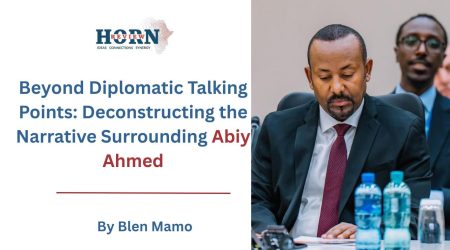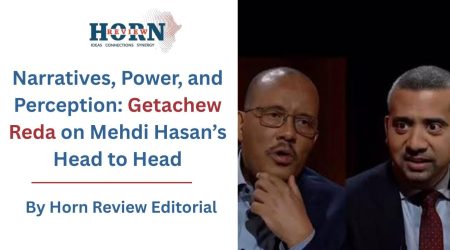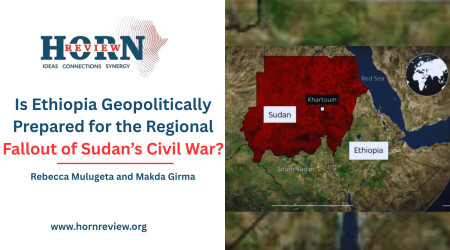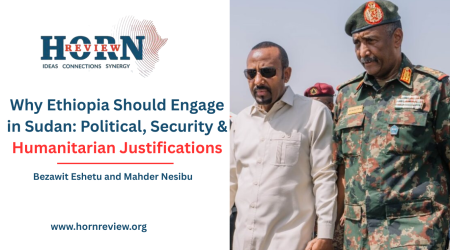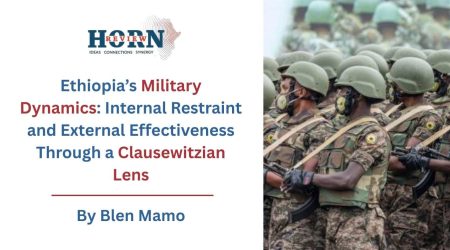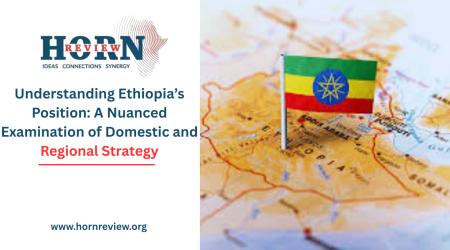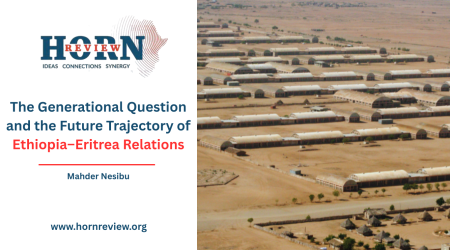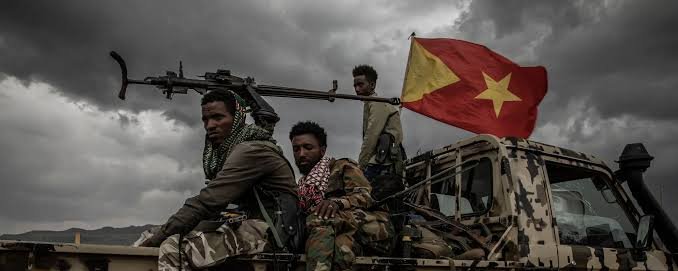
3
Jul
Undefined Relationships: Ethiopia’s Tigray Post-War Politics
In the tenuous and transitional landscape of post-war Tigray, the notion of “undefined relationships” has emerged as a vital analytical framework for deciphering the region’s intricate and evolving power dynamics. Following two years of devastating armed conflict, the cessation of hostilities achieved through the 2022 Pretoria Agreement brought an end to overt warfare. Yet, nearly three years into the post-conflict period, a constellation of actors with diverging loyalties and agendas continues to contend for dominance in the region.
At a forum organised by the Center for Responsible and Peaceful Politics (CRPP) in collaboration with Addis Ababa University, Assistant Professor Shewit Gebre-Egzabher, a senior lecturer at Mekelle University has recently cautioned that the Interim Regional Administration is increasingly perceived as politically fragile, with multiple centers of influence – many operating autonomously – challenging both the authority and coherence of regional governance. These fragmented dynamics have engendered an atmosphere of pervasive insecurity, as influential actors maneuver for position without clear institutional guardrails.
At the core of this volatility lies a series of poorly delineated, and often overlapping, relationships. Chief among them is the ambiguous interface between the Tigray Interim Regional Administration and the Tigray People’s Liberation Front (TPLF). Conceived as a transitional entity accountable both to Ethiopian federal statutes and the provisions of the Pretoria Agreement, the interim administration was designed to steward Tigray’s path toward normalization. However, the demarcation between the interim authority headquartered in Mekelle and the historic TPLF leadership has increasingly become indistinct.
While the Pretoria framework granted the TPLF a role in facilitating the interim setup – predicated on its renunciation of armed struggle – this mandate was swiftly interpreted by some elements within the party as a license to reassert influence beyond its originally envisaged scope. Certain hardline factions within the TPLF, including senior figures formerly affiliated with the Tigray Defence Forces (TDF), have used this opening to guide political developments from behind the scenes. Consequently, the genuine autonomy of the interim authority under Getachew Reda has faced structural impediments from its inception.
Initially, the TPLF proposed its own chairman, Debretsion Gebremichael, to lead the interim administration as regional president. This candidacy was declined by federal actors in favor of a more conciliatory option: Getachew Reda, a figure viewed as comparatively moderate. Nevertheless, this compromise proved short-lived. Approximately two years into the implementation of the Pretoria Agreement, internal currents within the TPLF mobilized to sideline Getachew’s faction – a shift undertaken with little transparency or public explanation. In the aftermath, General Tadesse Worede, a senior military officer regarded as broadly acceptable to multiple constituencies, emerged as a successor. Ostensibly, this appointment signified a renewed federal effort to preserve regional equilibrium. Yet in substantive terms, the TPLF’s internal apparatus appeared to have consolidated its dominance, achieving its objectives while outwardly maintaining the framework of a peace process. Ethiopian intellectuals from the Tigray region such as Shewit contend that the current administration under Tadesse is perceived to possess even less institutional strength and clarity of direction than that of his predecessor.
As a result, the interim administration now operates in a space where accountability appears increasingly oriented toward the TPLF’s internal hierarchy rather than toward federal mechanisms or constitutional statutes. The governing council in Mekelle remains divided in its allegiances – straddling the expectations of federal authority and the prerogatives of the TPLF’s central committee – with no clearly defined legal boundaries to mediate that duality. As Shewit aptly described, governance in Tigray has come to reflect a “rule of men” rather than a rule of law, where personal affiliations and strategic calculations overshadow institutional norms. The absence of enforceable distinctions between the interim authority and the TPLF has rendered the regional governance structure susceptible to informal power consolidation. Despite being constituted under federal law to ensure oversight and facilitate transition, the interim body has frequently functioned as though it derives its legitimacy primarily from historical party structures.
It is essential to underscore that the TPLF is not merely an armed militia but a political entity that dominantly governed Ethiopia under EPRDF – for over three decades, possessing an extensive understanding of diplomatic tools and statecraft. The party has long-standing alliances with a range of regional and global state and non-state actors, maintaining an intact network within Ethiopia that cannot be underestimated. This embedded infrastructure enables the TPLF not only to influence internal dynamics but also to remain a potent disruptive force within the country’s political landscape.
Throughout the 2020-2022 conflict, the TPLF considerably leveraged these networks to maximize its combat capabilities and galvanize diplomatic pressure against the federal government. Although reviving or expanding such relations today may not be as seamless as it was in 2020, the TPLF retains advantages that many other armed groups in the Amhara and Oromia regions lack. Its established external linkages, institutional experience, and historical legitimacy mean that dismissing its potential for disruption would be imprudent.
Moreover, internal divisions within the TPLF itself will inevitably affect its external relations, particularly with actors in Europe and the United States. These internal fractures and disunity will impact the party’s international posture and its capacity to sustain cohesive foreign alliances. Consequently, the evolving nature of these divisions warrants close observation, as they may influence the broader geopolitical dynamics involving the region.
While the shadow influence of the TPLF over the interim administration raises serious governance concerns, an even more delicate and potentially destabilizing ambiguity has emerged beyond Tigray’s borders. Despite the Pretoria Agreement’s explicit provisions prohibiting collaboration with hostile external actors, there are persistent reports of growing informal linkages between certain TPLF hardliners and the government of Eritrea. Though the TPLF has formally denied engaging in any such contacts, subtle indicators suggest a cautious warming of relations. Notably, the reopening of the Zalambessa border crossing – carried out not via an official diplomatic accord but through grassroots initiatives allegedly sanctioned by local authorities on both sides – suggests the quiet reactivation of bilateral channels. Complementary messaging from both TPLF and PFDJ affiliated media outlets, emphasizing the value of “people-to-people” ties, further contributes to the perception of thawing relations, despite the history of enmity between both parties.
Meanwhile, reports persist of Eritrean military presence in portions of Tigrayan territory – claims which the federal government has approached with prudence and discretion, likely to prevent the resurgence of hostilities. These subtle signals raise questions about the extent of any covert dialogue or understanding between Eritrean authorities and elements of the TPLF. If such communication is occurring, it would stand in clear contradiction to Article 3 of the Pretoria Agreement, which commits both signatories to refrain from engaging with foreign forces hostile to the other. Furthermore, Ethiopia’s constitutional order and post-conflict directives unambiguously prohibit unauthorized political engagement with foreign states by outlawed groups. Nevertheless, the opacity surrounding these developments enables all parties to maintain plausible deniability, further complicating efforts to enforce transparency and accountability.
This evolving TPLF–Eritrea dynamic is especially worrisome due to the strategic implications it carries for both regional peace and national security. Should Eritrean actors perceive Tigray’s political environment as fragmented or malleable, they may seek to expand their influence under the guise of informal cooperation. Historically, Eritrea has viewed Tigray as a buffer zone critical to its geopolitical calculus. A politically diffuse Tigray – devoid of strong institutions and clear affiliations – may inadvertently serve those aims. The apparent drift toward mutual accommodation between former adversaries underscores the urgency of clarifying the nature of these engagements and reaffirming the parameters set by the Pretoria framework.
In many respects, the current political ambiguity stems from issues left unresolved by both the war and the subsequent peace accord. At the heart of the original conflict was a long-standing tension between the TPLF’s assertion of regional autonomy and the federal government’s constitutional authority. Reforms introduced under Prime Minister Abiy Ahmed were perceived by the TPLF as existential threats to its long-held dominance, prompting military resistance rather than political negotiation. While the Pretoria Agreement successfully ended the active conflict, it did not compel a fundamental reassessment of the TPLF’s political posture. By affording the party a role in transitional governance, the accord may have inadvertently restored aspects of the power structure that the conflict itself had contested. Consequently, although hostilities have ceased, the foundational standoff remains, reframed within new institutional arrangements.
This fragile equilibrium is inherently unsustainable without deliberate political recalibration. Analysts warn that, should the prevailing dynamics persist, Tigray risks descending into renewed lawlessness or serving as a locus of interstate friction. Though the Pretoria Agreement was commendable in its achievement of a cessation of hostilities, its lack of explicit institutional safeguards has left key questions unresolved. The interim administration – originally conceived as an inclusive and temporary mechanism – has evolved into an extension of the TPLF’s organizational apparatus. Without credible mechanisms for oversight, each action by one party is liable to be interpreted with suspicion by others, perpetuating a cycle of distrust.
Looking ahead, it is imperative that the federal government continue its measured and strategic engagement in Tigray’s transition. Reasserting constitutional oversight – through enhanced transparency, security auditing, and inclusive administrative restructuring – can strengthen the credibility and functionality of the interim authority. This does not necessitate confrontation, but rather a reaffirmation of the legal framework underpinning the post-war settlement.
Simultaneously, the regional dynamics involving Eritrea must be approached with diplomatic precision. While war avoidance remains a priority, the terms of the ceasefire must also be vigilantly upheld. Coordinated efforts – potentially involving international mediators – could help facilitate the withdrawal of any remaining foreign forces. Ethiopia’s diplomatic and economic channels can further underscore that clandestine engagements contrary to constitutional principles will bear consequences, while encouraging lawful cooperation within the boundaries of national sovereignty.
Lastly, engagement with the TPLF requires strategic nuance. The Pretoria framework positioned the party as a transitional stakeholder. To ensure long-term stability, the inclusion of both legacy and emerging Tigrayan political actors is essential. Constructive dialogue with moderate elements within the TPLF – especially on urgent priorities such as the return of internally displaced persons (IDPs) and the Disarmament, Demobilization, and Reintegration (DDR) process – may yield pragmatic outcomes. Rather than pursuing exclusion, calibrated incentives could help reposition the TPLF within Ethiopia’s evolving political architecture in a more constructive role.
As the Tigray region remains a focal point of regional security interest, external powers with far-reaching influence across the Horn of Africa – from Cairo to Asmara, and from Port Sudan to Mogadishu – will continue to closely monitor any political or security decisions emerging from Mekelle. This scrutiny extends globally – from Washington to Moscow, Beijing to Brussels, and Dubai to Ankara – reflecting the complex geopolitical stakes involved. In this context, it is essential for the federal government to remain attuned to the shifting landscape of alliances between the TPLF and external actors – carefully analyzing the nature of these engagements, identifying their direct and indirect beneficiaries, and, most critically, assessing the economic undercurrents that sustain them. The international community, likewise, must grasp these complex dynamics and prioritize efforts to defuse internal tensions within Tigray while adopting preemptive deterrence strategies to forestall a regional catastrophe.
Absent timely and decisive action, the present ambiguities threaten to unravel the fragile peace Tigray now enjoys. The interim administration must be institutionally fortified, while covert foreign engagements must be confronted with clarity and resolve. If left unaddressed, these “undefined relationships” risk transforming political complexity into renewed conflict – jeopardizing not only regional stability but also national cohesion and security.
By Blen Mamo,Executive DIrector, Horn Review
By Mahder Nesibu,Researcher,Horn Review

